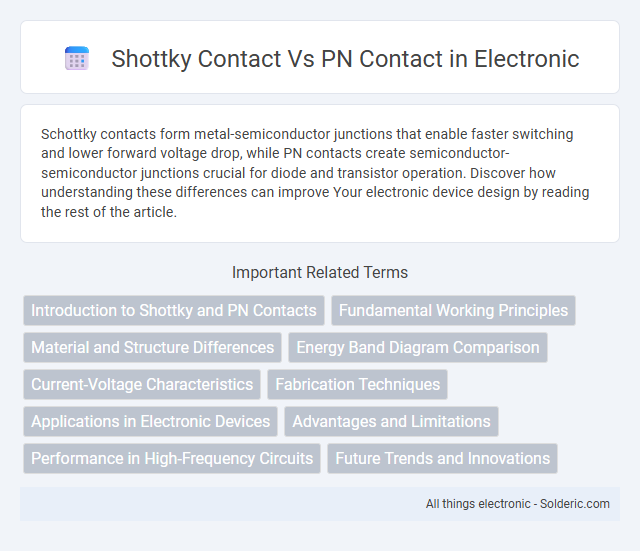Schottky contacts form metal-semiconductor junctions that enable faster switching and lower forward voltage drop, while PN contacts create semiconductor-semiconductor junctions crucial for diode and transistor operation. Discover how understanding these differences can improve Your electronic device design by reading the rest of the article.
Comparison Table
| Aspect | Schottky Contact | PN Contact |
|---|---|---|
| Type | Metal-Semiconductor Junction | Semiconductor-Semiconductor Junction (P-type and N-type) |
| Barrier Formation | Schottky Barrier (metal work function dependent) | Depletion Region due to carrier diffusion |
| Forward Voltage Drop | Low (~0.2 - 0.3 V) | Higher (~0.7 V in Silicon) |
| Switching Speed | Fast, due to majority carrier conduction | Slower, minority carrier recombination involved |
| Reverse Recovery Time | Minimal or negligible | Significant delay due to stored charge |
| Applications | High-speed switching, RF circuits, power rectifiers | Diodes, transistors, solar cells |
| Current Conduction | Majority carriers only | Both majority and minority carriers |
| Temperature Sensitivity | More sensitive due to metal-semiconductor interface | Less sensitive, standard semiconductor behavior |
Introduction to Shottky and PN Contacts
Schottky contacts are metal-semiconductor junctions characterized by a low forward voltage drop and fast switching speeds, primarily used in high-frequency applications and power rectifiers. PN contacts involve junctions between p-type and n-type semiconductors, forming the basis of diodes, transistors, and photovoltaic cells due to their rectifying behavior. Understanding the distinct electrical properties and interface mechanisms of Schottky and PN contacts is crucial for optimizing semiconductor device performance in various electronic systems.
Fundamental Working Principles
Shottky contacts operate based on the metal-semiconductor junction where the barrier height controls electron flow, enabling fast switching and low forward voltage drop. PN contacts rely on the p-n junction formed between p-type and n-type semiconductors, allowing charge carriers to recombine and generate a depletion region that regulates current flow. The fundamental difference lies in Schottky contacts using majority carriers for conduction, whereas PN contacts involve both majority and minority carriers, impacting response time and leakage currents.
Material and Structure Differences
Schottky contacts are formed by the junction between a metal and a semiconductor, typically involving metals like platinum, gold, or nickel paired with n-type silicon, resulting in a metal-semiconductor interface with a rectifying barrier. PN contacts consist of p-type and n-type semiconductor materials joined together, creating a p-n junction characterized by a depletion region controlling charge carrier flow. The structural difference lies in Schottky contacts having a metal-semiconductor interface with negligible depletion region width, while PN contacts exhibit a semiconductor-semiconductor interface with a well-defined depletion zone influencing charge separation and recombination.
Energy Band Diagram Comparison
The energy band diagram of a Schottky contact shows a metal-semiconductor junction with a distinct energy barrier called the Schottky barrier height, which controls electron flow and results in rectifying behavior with minimal minority carrier injection. In contrast, a PN contact features a semiconductor-semiconductor junction where the band bending forms a depletion region with a built-in potential that controls carrier diffusion across the junction, enabling both forward and reverse bias current regulated by recombination and generation processes. Understanding these band alignments helps optimize Your device performance in applications like diodes and transistors by selecting the appropriate contact type for desired electrical characteristics.
Current-Voltage Characteristics
Shottky contacts exhibit a unidirectional current-voltage (I-V) characteristic with low forward voltage drop and fast switching due to majority carrier injection, making them ideal for high-speed applications. In contrast, PN contacts display a nonlinear I-V behavior influenced by minority carrier injection, resulting in higher threshold voltages and slow response times. Your choice between Schottky and PN contacts depends on the specific electrical performance requirements of your device, especially regarding speed and voltage efficiency.
Fabrication Techniques
Shottky contact fabrication involves depositing a metal layer directly onto a semiconductor substrate using methods like vacuum evaporation or sputtering, creating a metal-semiconductor junction with a thin depletion region. PN contact formation requires doping techniques such as ion implantation or diffusion to create p-type and n-type regions, followed by precise annealing to activate dopants and form a p-n junction. Your choice of fabrication technique impacts device performance by influencing junction characteristics, contact resistance, and overall semiconductor behavior.
Applications in Electronic Devices
Shottky contacts are widely used in high-speed switching devices, such as Schottky diodes and RF mixers, due to their low forward voltage drop and fast switching capabilities. PN contacts, integral to bipolar junction transistors and solar cells, provide controlled charge carrier injection crucial for amplification and energy conversion. Your choice between Shottky and PN contacts impacts the efficiency and performance of electronic devices, especially in power management and signal processing applications.
Advantages and Limitations
Shottky contacts offer faster switching speeds and lower forward voltage drop compared to PN contacts, making them ideal for high-frequency and low-power applications. However, they exhibit higher reverse leakage current and lower breakdown voltage, which limits their use in high-voltage circuits. Your choice between Shottky and PN contacts depends on the trade-off between speed and voltage handling requirements.
Performance in High-Frequency Circuits
Shottky contacts exhibit lower forward voltage drop and faster switching speeds compared to PN contacts, making them ideal for high-frequency circuits. Their majority carrier conduction minimizes charge storage effects, significantly reducing switching losses. In contrast, PN contacts suffer from slower response times due to minority carrier recombination, limiting their efficiency at high frequencies.
Future Trends and Innovations
Shottky and PN contacts are evolving with advancements in materials such as 2D semiconductors and wide-bandgap compounds like GaN, enhancing efficiency and speed in electronic devices. Future trends include integrating Shottky contacts for ultra-fast switching and lower power loss, while innovations in PN junction engineering focus on improved thermal stability and scalability. Your choice of contact type will increasingly depend on application-specific demands for performance, reliability, and miniaturization in next-generation electronics.
Shottky contact vs PN contact Infographic

 solderic.com
solderic.com